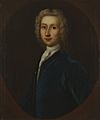Robert Whytt facts for kids
Robert Whytt (1714–1766) was a Scottish doctor. He is best known for his work on how our bodies react without us thinking (like reflexes). He also studied diseases of the nervous system, which includes the brain and nerves. He was even the President of the Royal College of Physicians of Edinburgh, a very important medical group.
Contents
Early Life and Education
Robert Whytt was born in Edinburgh, Scotland, on September 6, 1714. His father passed away before he was born. He went to the University of St Andrews and earned a degree in 1730. After that, he moved to Edinburgh to study medicine.
Whytt was very dedicated to learning about the human body. He studied anatomy, which is the study of the body's structure. He traveled to London to learn from famous surgeons like William Cheselden. He also visited hospitals there. Later, he went to Paris and Leiden to attend lectures from other important doctors. He earned his medical degree in 1736. In 1738, he became a fellow of the Royal College of Physicians of Edinburgh and started working as a doctor.
Career and Achievements
In 1747, Robert Whytt became a professor of medicine at Edinburgh University. This meant he taught students about how the body works and how to treat illnesses. He became a Fellow of the Royal Society of London in 1752. This is a very respected group for scientists. He also taught chemistry for a while.
In 1761, King George III made him his first doctor in Scotland. This was a special job created just for him! In 1763, he was chosen to be the president of the Royal College of Physicians of Edinburgh. He held this important position until he passed away in 1766 at the age of 52. His funeral was a public event, showing how much he was respected. He was buried in Greyfriars Kirkyard in Edinburgh.
Understanding the Nervous System
Robert Whytt was a brilliant neurophysiologist. This means he studied how the nervous system works. He made big discoveries about how our movements happen. He also figured out the difference between actions we choose to do and actions that happen automatically. He even explained how our eyes react to light.
The Central Nervous System and Movement
In Whytt's time, many people had different ideas about how our bodies move. Some thought that a special "animal spirit" fluid in our nerves made muscles contract. Others believed muscles could move on their own, without nerves. Whytt disagreed with these ideas. He thought that movement depended on nerves connected to the brain or spinal cord.
To prove his idea, Whytt did experiments with frogs. He would remove a frog's head and then poke its limbs. The limbs still moved! But when he destroyed the frog's spinal cord, the limbs stopped moving. This showed that the spinal cord was essential for these movements. This also proved that muscles needed nerves connected to the spinal cord to move. These automatic movements are now called "reflex actions."
Voluntary and Involuntary Actions
Whytt also studied the difference between actions we control and actions that happen without us thinking.
- Voluntary actions are movements you decide to make, like kicking a ball.
- Involuntary actions happen automatically, like your heart beating or your eye blinking when something gets too close.
Whytt believed that both our mind (or "soul," as he called it) and our body work together to create movement. He said that the mind helps us reason and also helps produce movement in our muscles. He showed that involuntary actions happen because of a signal (stimulus) acting on a part of our body, even if we're not aware of it.
The Pupillary Light Reflex
Have you ever noticed how your pupils (the black centers of your eyes) get smaller in bright light and bigger in dim light? This is called the pupillary light reflex. Whytt explained that this reflex is super important. Without it, we would only be able to see clearly in one type of light. We wouldn't be able to tell how far away objects are based on how much light they reflect.
Whytt discovered this reflex by studying a child who had hydrocephalus (fluid on the brain). The child's pupils didn't react to light. During an autopsy (an examination after death), Whytt found a cyst pressing on a part of the child's brain near the eye. He realized this pressure stopped the eye from reacting properly to light. This discovery led to the reflex being named the "Whytt Reflex."
Key Publications
Robert Whytt wrote many important medical books and papers.
- In 1743, he wrote about using lime-water to treat bladder stones. This treatment is not used anymore, but it was important at the time.
- In 1751, he published On the Vital and other Involuntary Motions of Animals. This book was very popular among doctors in Europe. In it, he explained his ideas about how automatic movements happen.
- His most important book, On Nervous, Hypochondriac, or Hysteric Diseases, came out in 1764. It talked about diseases of the nerves and how they affect the body.
His collected Works were published after his death in 1768.
Family Life
Robert Whytt was married twice. His first wife, Helen, passed away in 1741, and they did not have children. In 1743, he married Louisa Balfour. They had six children who survived. His grandson, Lewis Balfour, was the grandfather of the famous author Robert Louis Stevenson, who wrote Treasure Island and Strange Case of Dr. Jekyll and Mr. Hyde.
Images for kids





